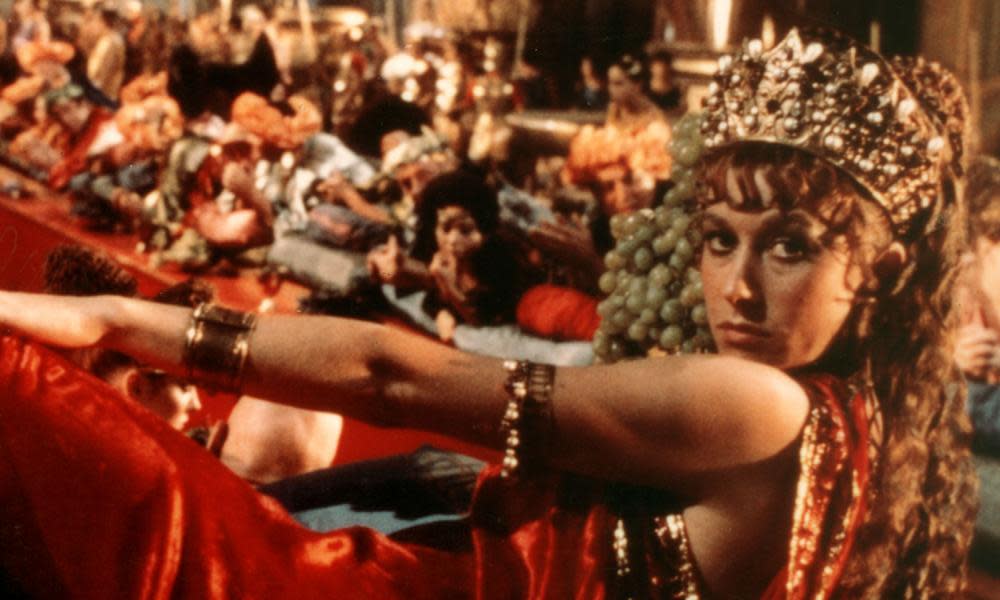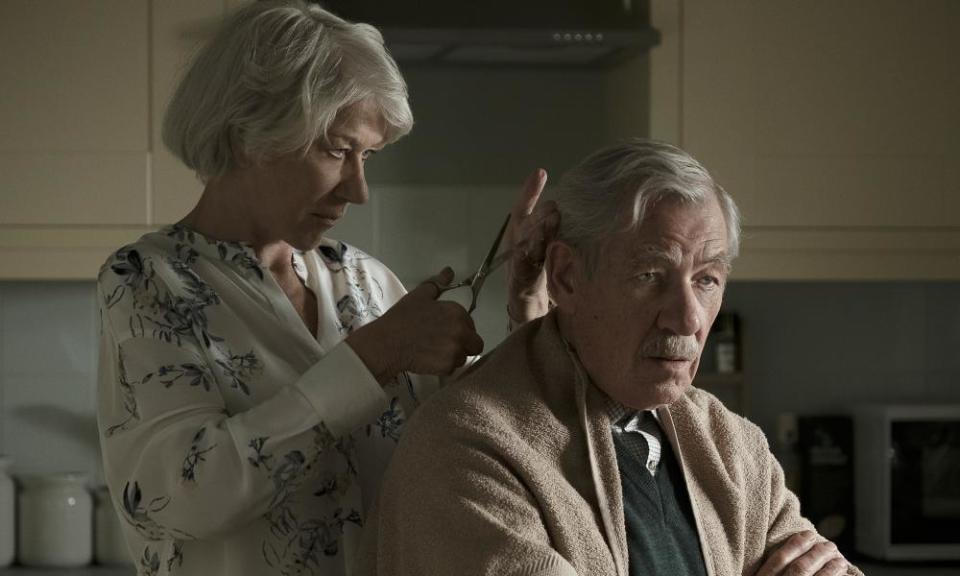Helen Mirren at 75: wild costumes, blazing performances – and a spell as a rock banshee

Who is Helen Mirren? Looking back over her career, as she hits 75, it is tempting to see her as two separate people. First, there was the outspoken young classical actor who fiercely resisted objectification, whether from newspapers (“Stratford’s very own sex queen” was a notorious Sunday Times headline) or TV chatshow hosts. Then came the mature Mirren with a gift for playing monarchs (Elizabeth I on TV, Elizabeth II on screen and stage), for picking up every award going, and for being a great dame associated with excellent causes. Among many, she is an ambassador for Women International.
Yet I see no great gulf between the two Mirrens. Having followed her career for 50 years, several things strike me. One is that she has always been a dedicated, highly skilled actor. Another is that she is a perennial mix of the nomadic and the majestic: you don’t get to play Cleopatra, as she did for the National Youth Theatre when she was 20, without some inbuilt imperiousness.
Indeed, one of my few brief encounters with her took place around that time, when I went to a party hosted by one of her Youth Theatre contemporaries. My abiding memory is of a self-possessed young woman who made many of the men at the party feel like boys (and I, for one, was five years older).
Where does that confidence come from? You could argue that it is partly genetic. It is well-known that she was born Helen Mironoff and that her paternal grandfather was a Russian aristocrat who fought in the tsar’s army and who was negotiating an arms deal in Britain when he and his family were stranded by the 1917 revolution.
One can make too much of this, but it is fascinating how many of the great British actors have foreign ancestry. John Gielgud’s stockbroker father came from a Slav family and Peggy Ashcroft’s mother was part Danish, part German-Jewish. I suspect, in Mirren’s case, that her bloodline is significant. It’s no accident that, when she was at the Royal Shakespeare Company, Trevor Nunn referred to her as a “Russian princess”, or that one of her biggest TV hits was as the empress Catherine the Great.
Yet within the aristocratic Mirren there has always been an adventurer up for any challenge. From 1967 to 71, she was a key member of the RSC, playing – among many other roles – Shakespeare’s Cressida and Ophelia, as well as Strindberg’s Miss Julie. With a classical career beckoning, she then upped sticks and went to Paris to join Peter Brook’s newly founded International Centre for Theatre Research.
Out of that came a journey to Africa in 1972, with Brook and a team of actors seeking to explore the origins of performance. The trip was rigorous and exhausting, but Brook paid tribute to Mirren’s improvisatory gifts. The basic performance tool was a carpet, and Brook has described how, one day in a village in northern Nigeria, “without warning this beautiful young actress jumped on to the carpet and twisted her body into a crumpled, limping, twisted hag”. She was so successful, in fact, that several distressed spectators rushed forward to help her.
Mirren returned Brook’s admiration in a way that had unforeseen consequences. In 1974, I went to Paris to cover his opening production of Timon of Athens at Théâtre des Bouffes-du-Nord. My review ended up containing a plea for the British – at a time when the embryonic National Theatre and the RSC were facing endless crises – to rediscover some of the “empty space” simplicity of Brook. To my astonishment, Mirren wrote to the Guardian endorsing my view and suggesting that the expenditure on sets and costumes at our national companies was “excessive, unnecessary and destructive to the art of theatre”.
Her letter opened up a big debate and even led to a question in parliament. What was extraordinary was that she wrote it as she was playing Lady Macbeth on the Stratford stage. Seemingly, however, she suffered no sanctions for her reckless candour.
Although Mirren had by now done a good deal of film and television, it was still the stage that seemed her natural métier. It was a sign of her versatility that, in 1975, she played both a self-destructive rock star in David Hare’s Teeth’n’Smiles at the London’s Royal Court, and Nina in The Seagull in the West End. I wrote of her Nina that instead of presenting us, in the final act, with the usual depleted wraith, she “showed us a woman who has learned through suffering how to endure”.
Back at the RSC, she also followed – not for the first time – in Ashcroft’s footsteps by playing Queen Margaret in Henry VI. I still remember her disdainful cry, as she viewed the chaos of civil broils: “Is THIS the government of Britain’s isle?” At the Royal Exchange in Manchester, she was also a stunning Duchess of Malfi: proud, sexy and impetuous.
If today Mirren is known to most people through her work on screens large and small, I suspect a turning point came in 1991 with Prime Suspect, written by Lynda La Plante, in which Mirren played Detective Chief Inspector Jane Tennison. Watching the first episode again, I was struck by how big a breakthrough this was and how it confirms my impression of Mirren as someone who can simultaneously be steely and vulnerable. Mirren’s Tennison is determined, obsessive and constantly battling the oppressive institutional sexism of the police force, yet she also shows the private cost of forever having to prove her right to operate in a man’s world.
Mirren did seven series of Prime Suspect and, while she has periodically returned to the stage, her fame now rests very much on film and TV. It would be tedious to list all her credits but it strikes me that, as when young, she is still a mix of the imperious and the adventurous.
Take two of her performances as Elizabeth II. In 2006, she played the title role in The Queen. Stephen Frears, who directed the film, said that when casting the role “it seemed essential to have someone who made you nervous”. Although the movie is about the Queen’s annus horribilis, when the death of Princess Diana exposed her failure to catch the public mood, Mirren still suggests that the monarch’s aloofness is ultimately a source of strength.
Mirren was back in royal robes in 2013 for Peter Morgan’s play The Audience. What impressed me was her capacity to convey the Queen’s mix of the extraordinary and the ordinary. She caught all of the monarch’s gift for adapting to a wide range of prime ministers: standing up to an ageing Winston Churchill, or smoking out the pretences of Anthony Eden during the Suez crisis. Yet Mirren also reminded us that virtually all plays about monarchy are studies of solitude: she gave us a woman who, for all her wealth and privilege, suffered a visible sense of entrapment.

Dipping into the scores of recent Mirren movies, it seems to me that her qualities remain constant. She has the poise and serenity that comes with age but she also suggests inner resilience. Look at her in Hitchcock, playing Alma Reville, the wife of the director; or her vengeful mark to Ian McKellen’s conman in The Good Liar.
Most fascinating of all is her role as Maria Altmann in Simon Curtis’s Woman in Gold, where she plays a woman seeking the restitution of a Klimt painting stolen from her family by the Nazis. She catches precisely the arrogance and impatience of an upper-class Austrian who will brook no argument. In fact, I was strongly reminded, yet again, of Peggy Ashcroft, who played a similarly authoritarian Austrian in a Stephen Poliakoff TV film, Caught on a Train.
So who exactly is Helen Mirren? She is a fiercely committed, hard-working, hugely gifted actor equally at home on stage or screen. But I cling to my belief that, although she has developed and widened her range with age, she is not vastly different at 75 from the woman I first saw playing Cleopatra when she was 20.


